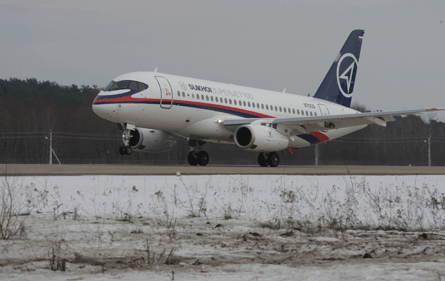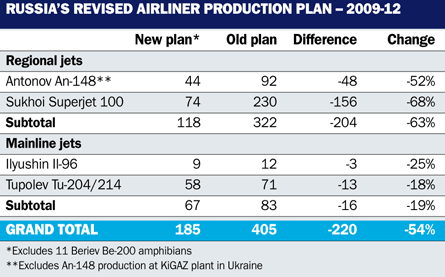Russia has responded to the global downturn by setting new output targets for the country's aerospace industry, which could threaten short-term production of the Sukhoi Superjet 100.
The announcement by state-runholding groupUnited Aircraft (UAC) will see overall planned airliner deliveries between 2009 and 2012 cut by more than 50% to fewer than 190 aircraft.
 |
|---|
© Marina Lystseva |
All the in-production airliner programmes being built by Russian plants are affected. Production during 2009-12 had been planned to exceed 400 aircraft - over half of which would have been the Superjet. UAC says the adjustment is needed because of the impact of the global financial crisis and weakening in demand for new aircraft following the reduction in passenger and cargo traffic. The company, however, asserts that military aircraft production plans remain unchanged.
However, it is unclear as to precisely how this will affect the Superjet, currently in flight testing. UAC figures suggest production of regional jets in total has been cut to 118, with 44 of these Antonov An-148s. However, Viktor Soubbotin, president of Sukhoi Civil Aircraft - a 75/25% joint venture between the Russian manufacturer and Finmeccanica of Italy - says the company's "current production plan is built upon the existing 98 aircraft firm order portfolio" and that annual production will reach 70 aircraft by 2012.
 |
|---|
One beneficiary of the revisions is the KAPO plant in Kazan, where the increased gross weight version of the Tupolev Tu-204, the Tu-214, is assembled. The plan for KAPO to curtail final assembly activities and switch to being a supplier of wings for a centralised Tu-204 assembly line at Aviastar in Ulyanovsk has been postponed. The plant will now produce a further 12 Tu-214s before transitioning to being a wing supplier.
Meanwhile, the revised plan looks to have scuppered any near-term revival of the Tupolev Tu-334 regional jet and Antonov An-124 freighter, with no production plan for either in 2009-12.
Source: Flight International























